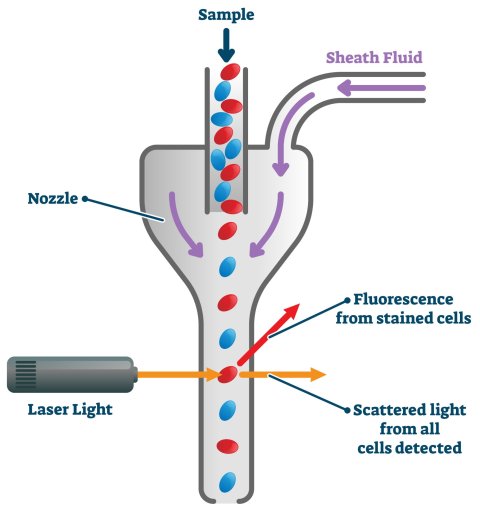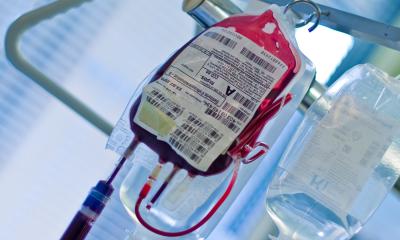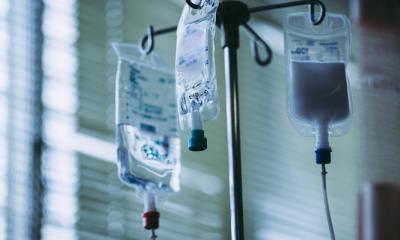Image source: Adobe Stock/Anusorn
Article • Flow cytometry
Detecting and measuring nanoplastics in the blood stream
Plastics are a part of everyday life, and an increasingly concerning factor of global environmental pollution. They also have infiltrated our bodies as microparticles (MPs) and nanoparticles (NPs), found even in placentas supporting foetal life. And they are in our blood. Now, researchers in Spain have developed a new method to detect and measure nanoparticles in human peripheral blood that is faster and more accurate than some current techniques being used.
Report: Cynthia E. Keen
Plastic MPs and NPs are ingested through oral intake of food and liquids, air inhalation, and exposure to the skin, such as bathing and using personal care products containing nanoparticles. Ranging in size up to 5 mm for MPs and from 1 nm to 1000 nm for NPs, they most commonly enter the body through food, drinking water, and use of plastic food contact materials.
Microplastics and nanoplastics are now known to induce inflammation, oxidative stress, immune response, and cell death through apoptosis and necrosis.1 When nanoplastics reach the blood stream, they circulate throughout the body. Because almost all blood from the intestinal tract transfers through the liver, this is a particularly vulnerable organ. Accumulations of plastic particles in the liver can penetrate the epithelial barrier.
A study, conducted by Chinese researchers at Shandong University’s Institute of Toxicology in Jinan and published in the journal Chemosphere, determined that that polystyrene nanoparticles increased blood-brain barrier (BBB) permeability and accumulated in the brains of mice.2 This accumulation triggered activation of microglia, the cells of the brain that regulate brain development, maintenance of neuronal networks, and injury repair. The researchers reported that their study revealed that polystyrene nanoparticles induced microglia activation and neuron damage in the mouse brain.
Recommended article

News • Altering the intestinal microbiome
How nanoplastics threaten human health
A recent review study concludes that nanoplastics change the composition and diversity of gut microbiome in vertebrates and invertebrates. The effects of a widespread and prolonged exposure to nanoplastics observed in animal models can be applied to humans.
Barcelona study reveals prevalence of plastics in the blood
Although more than a decade has been spent in intensive global research, the extent of harm plastic particles can cause to the human body is still unknown. Tens of thousands of variables are involved in terms of assessing exposure, hazards, and effects on human anatomy. Accurate and reproducible detection and measurement techniques are essential for all research.

Image source: Adobe Stock/VectorMine
A Universitat Autònoma de Barcelona research team has developed a simple, fast, robust, and reproducible method to detect nanoplastics in human peripheral blood using a flow cytometry method. Flow cytometry is a laser-based technique used to detect and analyze the chemical and physical characteristics of cells or particles. The researchers’ method, described in MethodX,3 is based on the fluorescent staining of Nile red, a dye that binds to the surface of plastics and neural lipids. Lead author Roser Salvia and colleagues used the lipophilic dye Nile Red, in combination with fluorescence techniques and nanocytometry to determine the presence in human peripheral blood of the four most common plastics produced in the world.
196 people living in the Metropolitan Area of Barcelona donated blood, ranging in age from new-borns to age 90. The donor cohort included 37 healthy individuals, 36 new-born infants, and 123 patients with type 1 diabetes multiple myeloma, three types of leukaemia, or non-small cell lung cancer. The researchers recruited the patients at different disease timepoints, which ranged from diagnosis and treatment to post-hematopoietic transplantation.
Their study to assess the capabilities and accuracy of their flow cytometry method was designed to prevent surface and airborne sample contamination by plastic particles and the environment. All measurements were performed in triplicate.
Based on the blood analysis, all participants had plastic particles in their blood. The researchers determined accumulation of plastics in participants aged 40 to 90 years slightly decreased as based on older age. ‘This suggests that the accumulation [of NPs] in other tissues, such as adipose tissue, cannot be ruled out,’ they write. ‘More studies will be needed to enlighten how plastics are accumulated with age, as an age-related phenomenon of redistribution and exposure to plastic pollution.’
The researchers also hypothesized that the air pollution in and around Barcelona was a potential source of plastic particle airborne inhalation. They conducted a laboratory study with mice, with results suggesting their hypothesis is accurate. The team recommends that studies be conducted to assess the accumulation of plastics in people living in rural areas and locales with different population densities.
References:
- Hu M, Palić D: Micro- and nano-plastics activation of oxidative and inflammatory adverse outcome pathways; Redox Biology 2020
- Shan et al.: Polystyrene nanoplastics penetrate across the blood-brain barrier and induce activation of microglia in the brain of mice; Chemosphere 2022
- Salvia et al.: Fast-screening flow cytometry method for detecting nanoplastics in human peripheral blood; MethodsX 2023
11.07.2023











